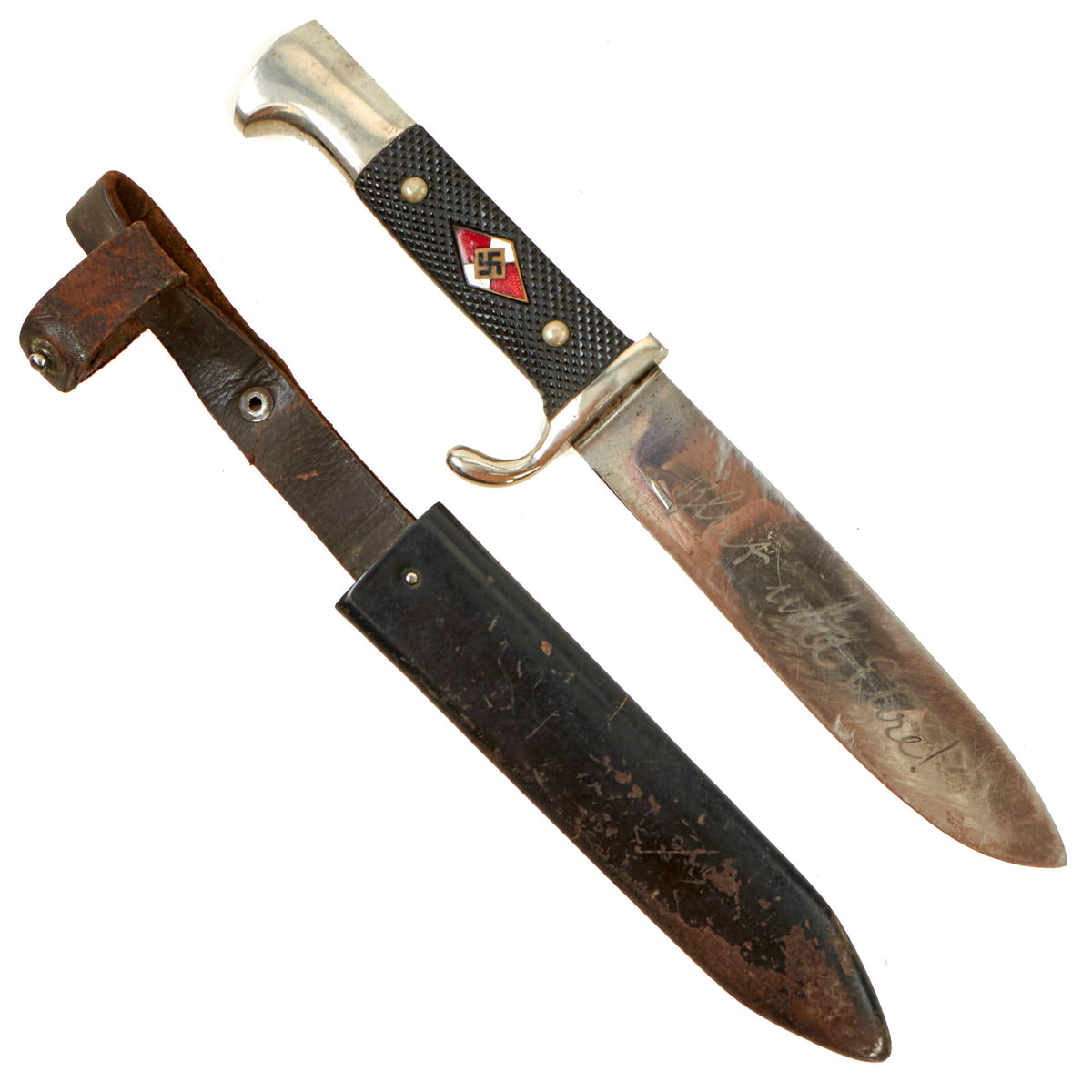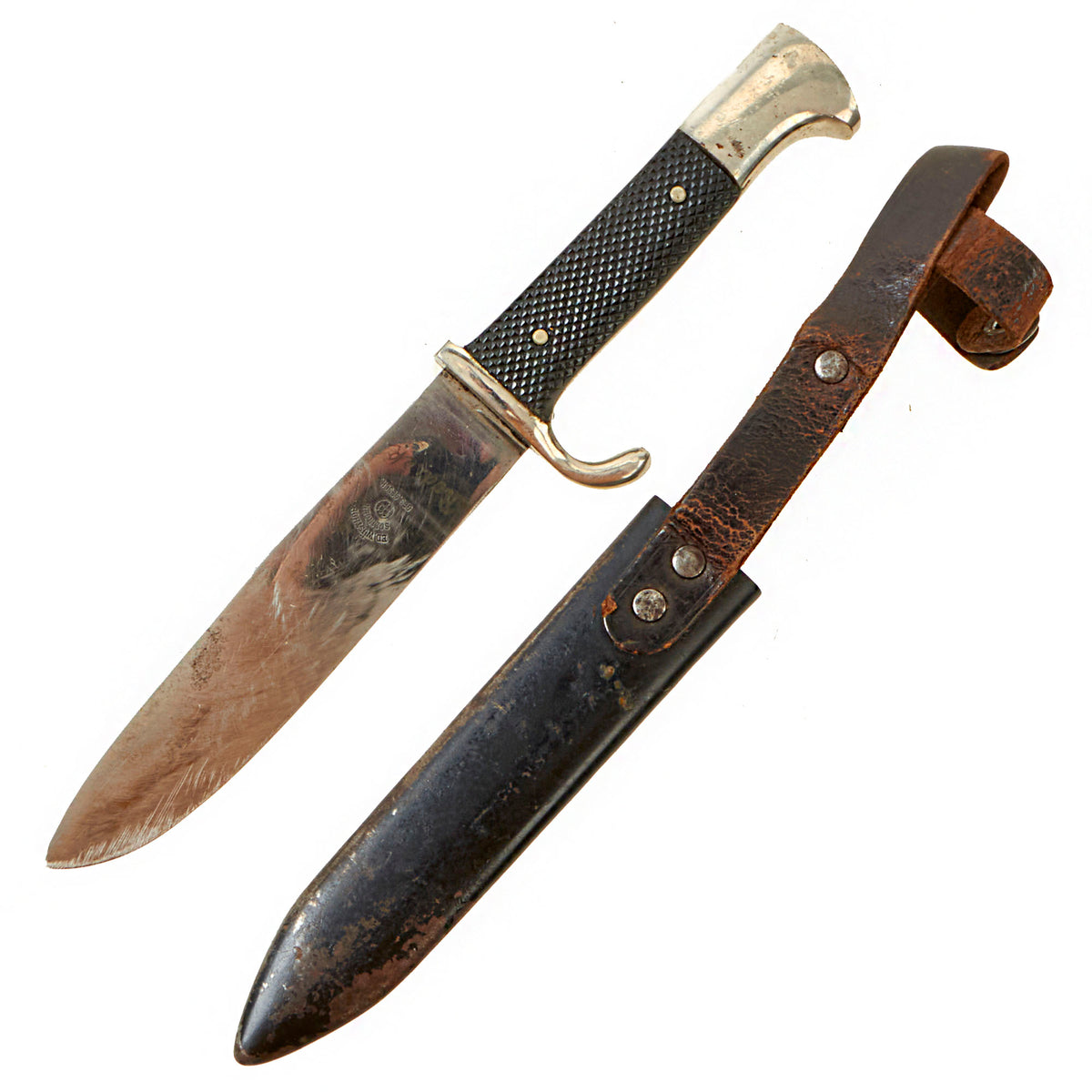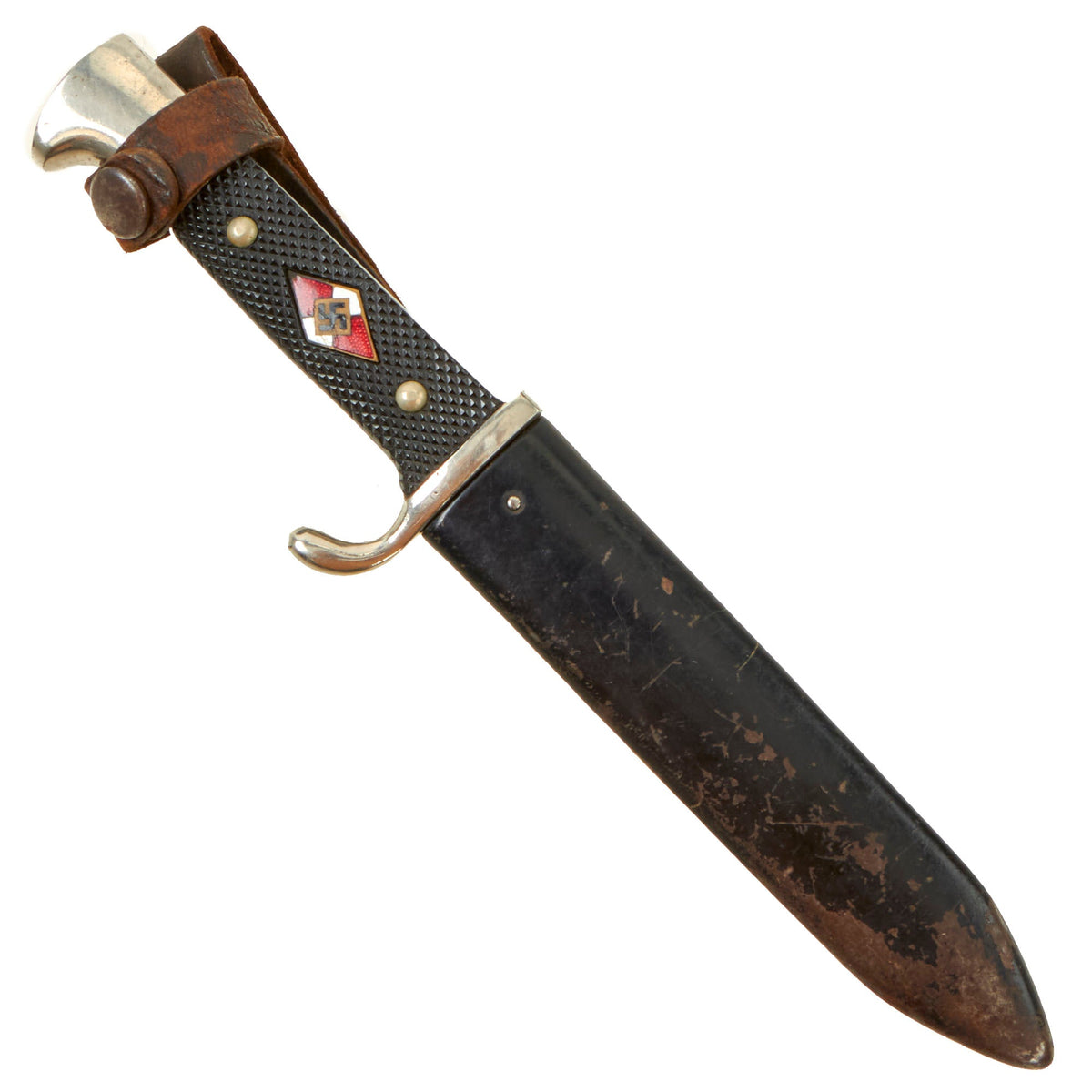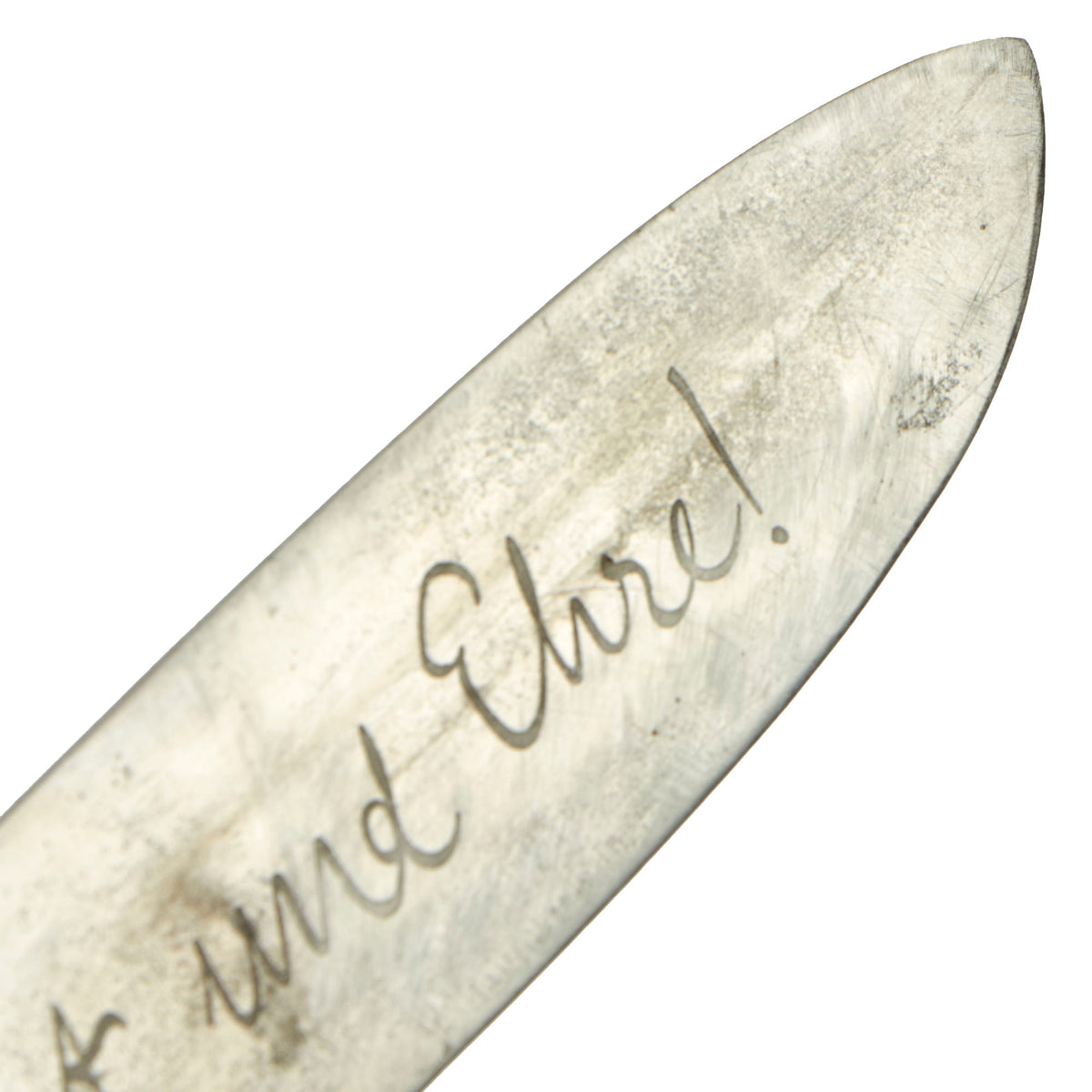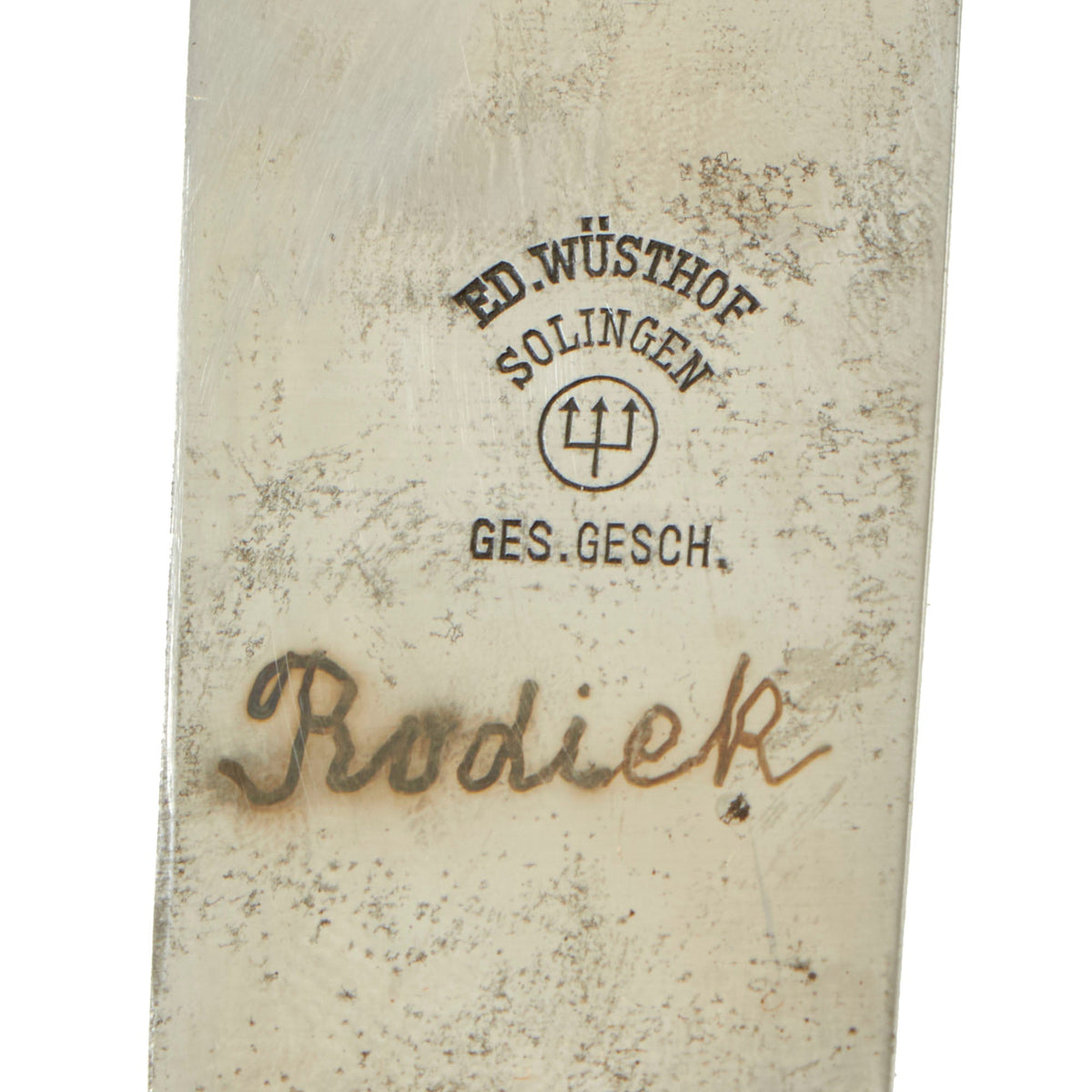Original German WWII Early Motto-Marked HJ Knife by Eduard Wüsthof of Solingen with Scabbard Original Items
$ 995,00 $ 248,75
Original Item: Only One Available. This is a very good condition early HJ National Youth Organization Fahrtenmesser (trip knife), marked on the blade by the well-known firm of Eduard Wüsthof, Dreizackwerk (Trident Works) of Solingen. This early HJ Knife is a solid example of the type, with a handle that is nickel-plated over a steel base. The plating still remains in very good condition, with over 90% intact, showing some small areas of wear and oxidation. The acid-etched motto Blut und Ehre! (Blood and Honor!) is present and crisp, and still retains a good amount of the factory darkening.
The Bakelite grip plates are closely checkered and in excellent condition, retained by nickel alloy rivets with dressed obverse heads. The HJ insignia is also in great condition with only a bit of wear, and with the enamel mostly intact. The plating has worn off the brass, which now has a mellow patina. The bakelite shrinks slightly over the years, which is why the emblem on this example is a bit loose and sunken in, confirming authenticity.
The blade of this example is solid, and is typical of the early period up until 1936. It has a thinner blade with no raised ricasso, and also no RZM codes. The blade still retains visible factory final polish grind cross grain over much of the surface, especially near the ricasso. This texture is iconic, and is the definitive identifying characteristic for a real WWII German Blade. The blade definitely did see some level of service, as there is wear on the upper half of the blade, and definitely evidence of sharpening. There is also evidence of light staining, now polished away. It has the great look of an honest lightly used knife, and the blade is currently somewhat sharp.
On the reverse the blade is marked:
ED. WÜSTHOF
SOLINGEN
(TRIDENT LOGO)
GES. GESCH.
The “Trident in a Circle” is a trademark used by Ed. Wüsthof, Dreizackwerk (Trident Works), located in Solingen, the legendary “City of Blades” in western Germany. During the WWII Period they manufactured many HJ Knives, both with their trademark and later with the RZM code M7/19. The firm was founded in 1814 by Johan Wilhelm Wüsthof, and recently celebrated its 200th anniversary. It is one of the premier mid-sized cutlery companies in Germany today. For more information please see GERMAN KNIFE AND SWORD MAKERS by J. Anthony Carter.
The design of the knife is registered with the German trademark office, indicated by the Ges. Gesch., which is short for Gesetzlich Geschützt (Protected by Law). The original leather blade buffer is no longer in place, having deteriorated over the many years. There also is the name Rudiek written on the blade, probably with some type of marker, which has now oxidized into the surface.
The scabbard shell the typical tapered example with original black enamel paint, which is retained at over 80%. There is wear on the edges and towards the tip, and there is also some checking and crazing in the enamel, confirming the great age and that the scabbard has not been repainted. The leather belt loop is intact and very nice, with a good working snap on the retainer loop, though the leather is somewhat delicate.
A wonderful HJ Knife with a very nice early pattern blade in great collectible condition! Ready to display!
Specifications:
Blade Length: 5 5/8″
Blade Style: Single Edged Knife
Overall length: 9 3/4”
Crossguard: 1 7/8”
Scabbard Length: 5 7/8” with belt loop
AH believed German youth to be the future of his 3rd Reich. The HJ (AH Jugend) was formed officially in 1935, and with the exception of NSDAP ideology indoctrination was very similar to the Boy Scouts. Beginning at about the age of ten years, both boys (AH Jugend) and girls (Bund Deutscher Mädel) were enlisted in the Party-run organization. The boys only were given HJ Knives after having passed minor exams. The knives had nickeled hilts with black checkered grip plates. The obverse plate was fitted with an enameled HJ swas insignia. Through 1937, these knives were etched with the motto of the organization, Blut und Ehre! (Blood and Honor!). Examples produced after this date were made with plain blades usually bearing an RZM marking.
The HJ Leaders were professionals in charge of the training and NSDAP education of the German Youth. They wore a special dagger consisting of silvered hilt fittings with blue-black leather-covered scabbard. The grip was composed of tightly wrapped silver wire, over a wood base. The pommel cap featured an HJ diamond on top, complete with swas. The upper scabbard fitting portrayed an open-winged HJ eagle with swas cut into the bird’s chest. The blade was etched with the HJ motto, Blut und Ehre!
Fast Shipping with Professional Packaging
Thanks to our longstanding association with UPS FedEx DHL, and other major international carriers, we are able to provide a range of shipping options. Our warehouse staff is expertly trained and will wrap your products according to our exact and precise specifications. Prior to shipping, your goods will be thoroughly examined and securely secured. We ship to thousands clients each day across multiple countries. This shows how we're dedicated to be the largest retailer on the internet. Warehouses and distribution centres can be located throughout Europe as well as the USA.
Note: Orders with more than one item will be assigned a processing date depending on the item.
Before shipping before shipping, we'll conduct a thorough inspection of the items you have ordered. Today, the majority of orders will be delivered within 48 hours. The delivery time will be between 3-7 days.
Returns
The stock is dynamic and we cannot completely manage it because multiple stakeholders are involved, including our factory and warehouse. So the actual stock may alter at any time. It's possible that you may not receive your order once the order has been made.
Our policy is valid for a period of 30 days. If you don't receive the product within 30 days, we are not able to issue a refund or an exchange.
You can only return an item if it is unused and in the same state as the day you received it. You must have the item in its original packaging.
Related products
Uncategorized
Angolan Rebel 1970s era 60mm Inert Display Mortar from Angolan Civil War Original Items
Uncategorized
Uncategorized
Uncategorized
Uncategorized
Uncategorized
Uncategorized
Uncategorized
Australian WWII Owen MK1 Machine Carbine SMG Custom Fabricated Replica with Sling Original Items
Uncategorized
Uncategorized
Band of Brothers ORIGINAL GERMAN WWII Le. F.H. 18 10.5cm ARTILLERY PIECE Original Items
Uncategorized
Uncategorized
Uncategorized
Armored Burgonet Helmet & Polearm from Scottish Castle Leith Hall Circa 1700 Original Items
Uncategorized
Uncategorized
Uncategorized
Uncategorized
Uncategorized
Uncategorized
